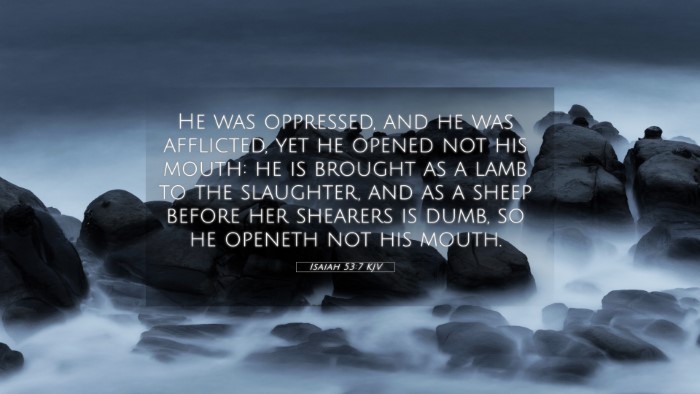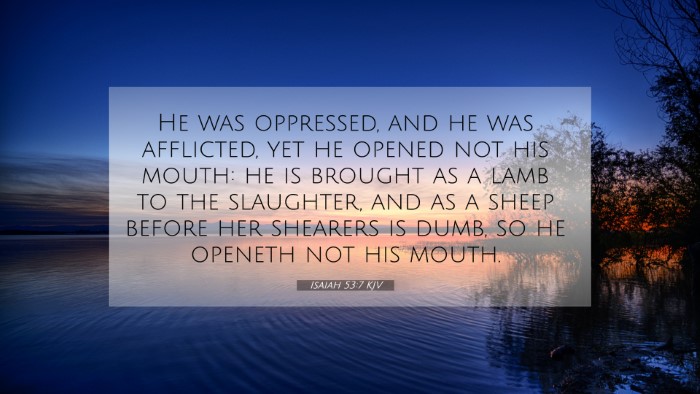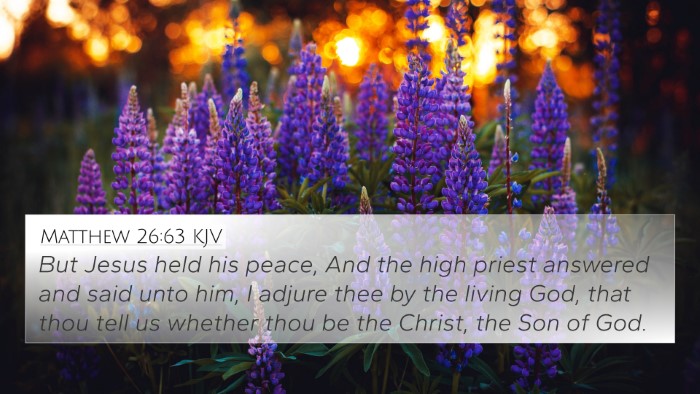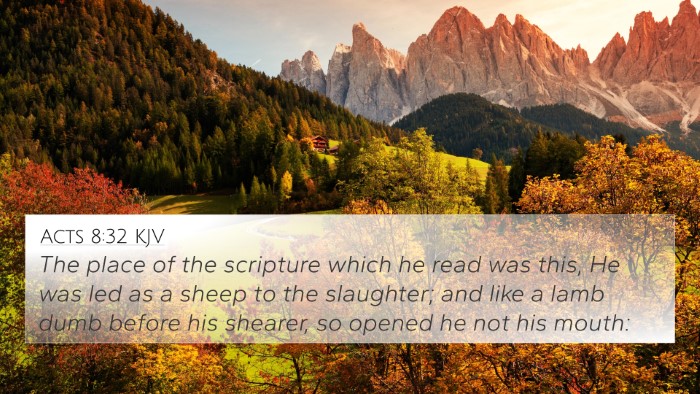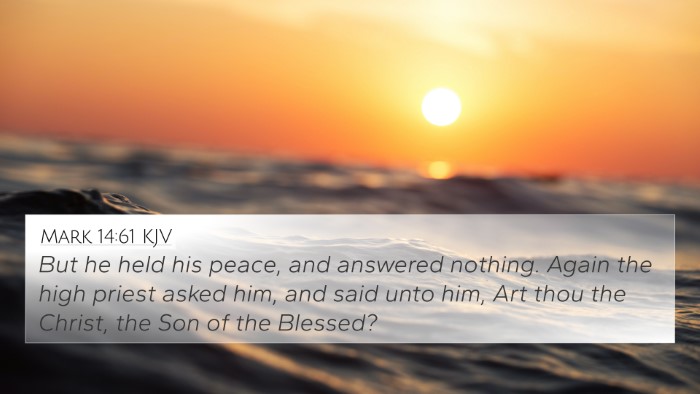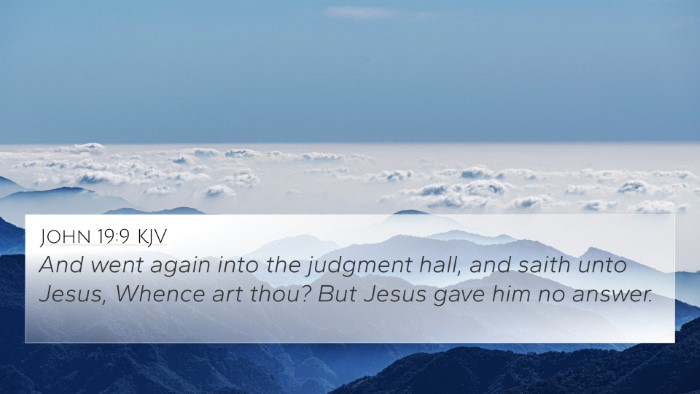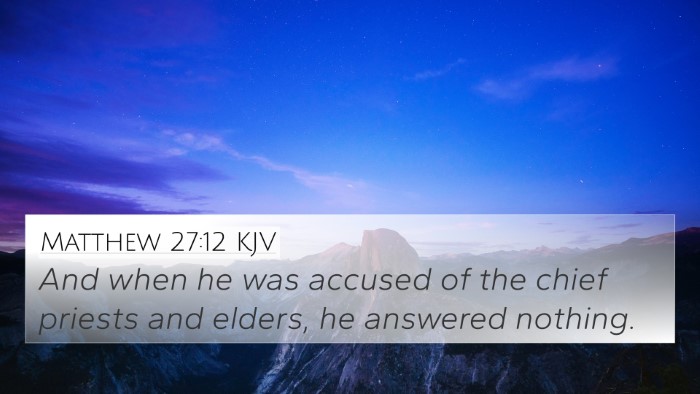Understanding Isaiah 53:7
Isaiah 53:7 is a profound verse that speaks to the suffering and humility of the Messiah. This verse highlights the theme of vicarious suffering, where the righteous suffer for the unrighteous. Here, we explore the verse's meaning and connections with other Scriptures, using insights from respected public domain commentaries.
Verse Text
Isaiah 53:7 (KJV): "He was oppressed, and he was afflicted, yet he opened not his mouth: he is brought as a lamb to the slaughter, and as a sheep before her shearers is dumb, so he openeth not his mouth."
Verse Meaning
Isaiah 53:7 illustrates the archetype of the suffering servant, emphasizing his quiet submission and endurance in the face of injustice and suffering. The verse suggests several interpretations:
- Oppression and Affliction: The phrase "he was oppressed, and he was afflicted" signifies the severe injustices faced by the servant, often interpreted as a prophecy concerning Jesus Christ's trials and ultimate suffering for mankind.
- Silence in Suffering: The servant's silence reflects both submissiveness and the fulfillment of God's plan. As noted by Matthew Henry, this silence is a mark of dignity, showing that the servant does not engage in defense or retaliation.
- Symbolism of the Lamb: The imagery of being "brought as a lamb to the slaughter" captures the idea of innocent suffering, reinforcing the sacrificial nature of the servant's mission, as highlighted by Adam Clarke.
- Fulfillment of Prophecy: This verse is often linked to New Testament accounts of Jesus' trial, where He remained silent before His accusers, indicating a direct fulfillment of the prophecy.
Cross-References to Isaiah 53:7
To further understand Isaiah 53:7, we can explore several related Bible verses:
- Matthew 26:62-63: During His trial, Jesus did not respond to the accusations against Him, mirroring the silence described in Isaiah 53:7.
- John 1:29: Here, John the Baptist refers to Jesus as the "Lamb of God," drawing a parallel to the sacrificial imagery in Isaiah.
- Acts 8:32-35: The passage discusses Philip explaining Isaiah 53 to the Ethiopian eunuch, showcasing the understanding of Jesus' fulfillment of this prophecy.
- 1 Peter 2:23: Peter refers to Christ's silence before His accusers, drawing a direct link to the Isaiah prophecy of the suffering servant.
- Revelation 5:6: The mention of the Lamb in the context of the throne emphasizes the sacrificial role and the fulfillment of the prophecy through Christ.
- Isaiah 50:6: This verse further emphasizes the servant's willingness to endure suffering and humiliation, reinforcing the themes found in Isaiah 53:7.
- Hebrews 9:14: This reinforces the sacrificial nature of Jesus and the efficacy of His suffering for our redemption.
- Psalm 44:22: A verse that reflects the notion of suffering for God’s sake, emphasizing the shared theme of vicarious suffering.
- Romans 8:36: This provides a New Testament reflection on being "killed all the day long," aligning with the suffering aspect of Isaiah's prophecies.
- Philippians 2:7-8: Highlights the humility of Christ as He took on the form of a servant and became obedient unto death.
Thematic Connections
The themes of suffering, sacrifice, and obedience found in Isaiah 53:7 resonate throughout Scripture. Understanding these connections enhances our interpretation of Biblical texts:
- Vicarious Suffering: The concept of dying for others' sins is underscored through various texts, establishing a thematic thread from the Old Testament prophets to the New Testament teachings.
- Redemptive Suffering: This idea spans both the Prophets and Apostolic teachings, providing a cohesive narrative of redemption through suffering.
- Sacrificial Love: The enduring love of Christ portrayed through His suffering speaks to the core of Christian theology, inviting deeper contemplation of what it means to bear one's cross.
Conclusion
Isaiah 53:7 serves as a powerful reminder of the depth of Christ's suffering and the importance of His silent submission to God's will. By employing cross-referencing Bible study tools, readers can appreciate the connections between this verse and others throughout Scripture, leading to a more comprehensive understanding of the Biblical narrative. Exploring these themes through a comparative Bible verse analysis fosters a richer dialogue within the Bible, illuminating the profound truths of faith and sacrifice.
Tools for Bible Cross-Referencing
To aid in the exploration of Isaiah 53:7 and its connections to other Scriptures, consider utilizing the following:
- Bible Concordance: A comprehensive tool for finding specific words and where they appear in the Bible.
- Bible Cross-Reference Guide: Provides context and relationships between various verses.
- Cross-Reference Bible Study: An effective method for drawing connections and understanding themes across the Scriptures.
- Bible Reference Resources: Explore various printed materials and online resources to aid in study.
- Bible Chain References: A method to follow a series of related verses that build upon a theme or concept.

